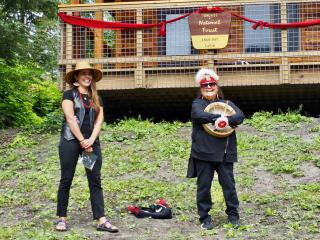Anan Bay rebuild marks new chapter in Alaska cabins project
ALASKA — The Anan Bay Cabin near Wrangell, Alaska, is once again open for reservations, just a year and a half after the former structure was flattened by a fallen spruce.
An August ribbon-cutting ceremony brought together Forest Service representatives with those from the Wrangell Cooperative Association, National Forest Foundation and local students who installed livecams at the nearby Anan Wildlife Observatory.
Esther Aaltséen Reese, tribal administrator for the Wrangell Cooperative Association, offered a tribal welcome and sprinkled tobacco on the ribbon before U.S. Senator Lisa Murkowski made the cut. The ceremony commemorated a significant moment for their community and a milestone for the Alaska Cabins Project.
The Alaska Cabins Project is a partnership between the National Forest Foundation and Forest Service that is building, reconstructing and repairing up to 25 public-use cabins across the state’s national forests. It is made possible by a nearly $14 million investment from the Infrastructure Investment and Jobs Act, with the foundation fundraising an additional $3.7 million.
The Anan Bay Cabin is the project’s first cabin to be completed in the Tongass National Forest and second state-wide.
“Cabins in the Alaska Region fill an important niche,” said Director of Recreation, Lands, and Minerals James King, who was among those gathered behind the ribbon on the cabin porch. In a state where both national forests tend to be rainy and cool, “There are people happy to hike all day in the pouring rain, but after that, they are not always so excited to get into a wet tent.”

Cabins encourage people to get out on their public lands, but how people choose to use these lands has shifted over time. “Today, more people want cabins closer to communities—on the road system, close to a trail or a short distance on protected waters.”
National Forest Foundation President and CEO Mary Mitsos was among those who traveled to Anan for the ceremony. Mitsos said that the shifting demand from public land users is integrated into the broader strategy for the Alaska Cabins Project. She added that this includes constructing new cabins with accessibility in mind.
In addition to fundraising to help pay for the construction of new cabins, the National Forest Foundation contracts with builders to construct the cabins and works with agency staff to ensure the cabins are built to specifications.
Before its encounter with the fallen spruce, the former Anan Bay Cabin had been popular with the local community and visitors. Its proximity to Wrangell as well as the Anan Wildlife Observatory made it a good fit for the broader strategy of the Alaska Cabins Project and a top priority.
The Anan Bay Cabin was among the first in line for reconstruction, but another factor put it on the fast track to completion—it would be one of the first to use a new, standardized cabin design.

King explained that the ready-to-use layout may save time throughout the process, starting with planning. Instead of drafting a design from scratch, engineers tailor the standard layout to local snow load, seismic, wind and soil conditions, but the basic box stays the same.
When it comes time for repairs, there may be labor savings as well, noted King. “If a window breaks and you know it is part of the standard cabin package, you know the size and might already have an extra one on the shelf.”
The Anan Bay Cabin is now open for reservations, year-round, on recreation.gov. This fast-tracked prototype was just one of the projects underway at Anan in 2024.
After the ceremony at the cabin, participants took a short boat ride to the Anan Wildlife Observatory to experience other recent additions--a new viewing platform with a spiral staircase, and nature livecams installed by Wrangell High School students.
"The ribbon cutting was a small celebration that represented much bigger things,” reflected Wrangell District Ranger Tory Houser. “It represented the beginning of the Alaska Cabins Project implementation and an ever-strengthening relationship with tribes, municipalities, businesses and schools. It was just the tip of the iceberg.”


